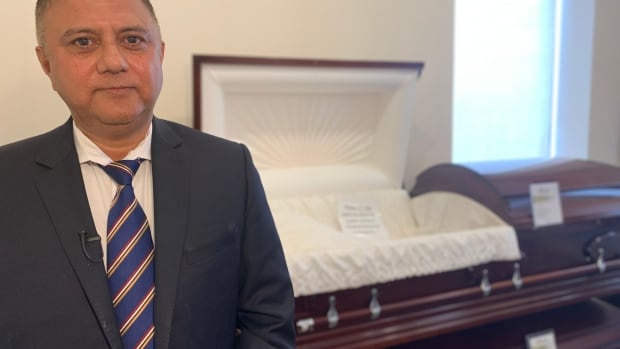Global Courant 2023-05-24 13:00:00
WARNING: This story contains disturbing details
A funeral home in Toronto is drawing attention to mental health issues faced by international students as it increasingly repatriates the remains of young men and women to India.
Funeral workers at the Lotus Funeral and Cremation Center in Etobicoke, Ont., say some of these deaths are the result of suicides. Students and advocates say they are similarly concerned about the mental health of international students and suicide rates, especially as the international student population from India grows, saying the issue requires action.
The numbers are murky. A student activist says it’s problematic that federal statistics don’t track international student deaths because otherwise there’s no way to find a solution.
Lotus has for years repatriated the remains of Indian citizens from across Canada at the request of the Consulate General of India and other members of the diaspora.
Previously, no more than two were repatriated per month – some of them were students and others had received work permits. But since last year, that number has more than doubled, says the funeral home.
President and owner Kamal Bhardwaj says the funeral home has seen a year-on-year increase in the number of bodies, mainly of young people, being repatriated to India. (Kirthana Sasitharan/CBC)
“We are now about four to five (repatriations) a month,” said president and owner Kamal Bhardwaj. Some months as many as seven. Funeral workers have traveled as far as PEI, New Brunswick, Nova Scotia, Manitoba and Quebec to collect bodies.
Here’s the breakdown of those repatriations, which the funeral home says were mostly young people:
2018: 8 Remains.2019: 16 Remains.2020: 12 Remains.2021: 11 Remains.2022: 33 Remains.
Funeral directors say they are troubled by some of the signs they see on bodies.
“It’s more of a visual. When they come in, how do we see it and sometimes there are ligature marks on the neck,” Bhardwaj said. “So that would be something that we think is suicide.”
While ligature marks could be caused by other incidents, funeral directors say, in other cases, employees see signs of drowning or drug overdose, which could also indicate suicide.
Funeral directors were unable to name specific causes of death due to privacy concerns, but they did tell CBC News that natural causes are usually associated with only one or two deaths per month among students and other young Indians.
The rest includes accidents, suicides, accidental drug overdose, or other causes. In some cases, determining the cause of death takes time, as it can take weeks or months to confirm the coroner’s inquest, funeral directors said.
Funeral director Harminder Hansi says he, as a parent himself, has a hard time seeing the apparent causes of death of some of the young people the home sends back to India. (Kirthana Sasitharan/CBC)
Funeral director Harminder Hansi says the home is on track to surpass even last year’s repatriation numbers.
“I’m burnt out,” he said. “As a parent, when I see how they died, the cause of death, it upsets me. Why did this happen, why we…as a community, why (can’t we) stop this?”
There were also many more students coming to Canada from India last year – 319,000, up from 216,500 in 2021 – according to Immigration, Refugees and Citizenship Canada (IRCC). But that 47 percent increase was more than outweighed by the increase in the number of bodies treated by Lotus.
According to IRCC data, the number of Indian students with valid study permits is on the rise:
2018: 171.505.2019: 218.540.2020: 179.510.2021: 216.500.2022: 319.000.
IRCC said it does not track the remains of foreigners returned to their home countries. Statistics Canada says that while it does collect information on deaths, there isn’t enough information to determine if the deceased was a foreign student.
The Consulate General of India (CGI) in Toronto — which mainly caters to students in Ontario — says that in 2021, 22 of those registered with the consulate died of the province’s 173,935 who had valid study permits. Four of those were suicides.
Amanjit Kahlon, of the Punjabi Community Health Services, says homesickness has a lot to do with students’ stress. (Kirthana Sasitharan/CBC)
Both student numbers and consulate suicides also rose in 2022 — when 25 of the 236,565 died and seven were confirmed as suicides — though the change as a percentage of the student population seems proportional.
The consulate was unable to provide CBC News with segregated data before 2021.
According to consulate officials, another eight students had died in March so far this year. Two of these were confirmed as suicides.
Jaspreet Singh, founder of the International Sikh Students Association and a former international student himself, says if governments don’t monitor the deaths of international students, it will be difficult for officials to see the crisis he and others in the community see one day . daily.
“In Canada, everything is pretty much systematic,” he said. “We work with numbers, we always try to analyze the number, we always try to project the numbers into the future. In the case of (international students), nothing happens.”
“They are neglected and only the students suffer.”
Singh says the pressure for international students increases over time — from applying for study permit renewals to paying tuition fees, to working while grades remain high and waiting for immigration pathways.
If those students can’t live up to the “expectations of their family and friends…from a South Asian perspective, it’s a matter of life or death if they feel like they’ve failed.” Singh said.
Homesickness is “a big part of the problem,” said Amanjit Kahlon, community development manager at Punjabi Community Health Services (PCHS), which helps members of the South Asian community access mental health services. Over the years he has seen that more people need access to this support.
“Many of these people come from large families where someone comes over to ask them how their day was. When they come here, a lot of them are alone. They’re in a new space, but they don’t have that connection or that social support .”
Kahlon says the organization has had to intervene in the past to support student mental health, even going so far as sending some back to India through the Rapid Response, Saving Lives program. It helped send nine students home before their mental health deteriorated, at the request of the students and their families.
“We followed up with the majority of them once they got back and the families are very grateful that they were able to understand what their child was going through,” Kahlon said.
The organization no longer receives a provincial subsidy. Kahlon says case managers at PCHS can have up to 100 cases at a time.
“If we see an increase in the size of the international student population, then there should be more funding for programs that support them,” he said.
Josh Sankarlal, a board member of the Ontario Undergraduate Student Alliance (OUSA), says institutions have historically struggled to address student mental health, but the mental health of international students in particular is nuanced.
“I think the culture a student comes from can really affect how comfortable they feel about accessing mental health services,” he said.
OUSA has recommended that institutions and governments take a community approach. This includes working with service providers so that students can access mental health services in places of cultural significance.
Colleges Ontario also recently released a new international standard of practice, which will come into full effect for the 23 signatory colleges in June 2024.
One of the standards includes “support and services to promote student well-being and safety”. Specifically, colleges will be required to provide students with information on how to access medical and mental health services through the college or through community and public services. This includes culturally responsive services when available.
“One student death by suicide is already too many.” Sankarlal said. “What students really want is to have their mental health treated as urgently as their physical health.”
If you or someone you know is struggling, get help here:




